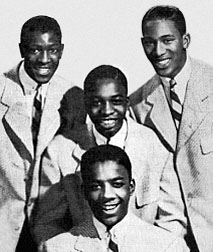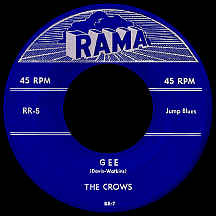THE CROWS
Gee
In 1951, Daniel "Sonny" Norton and his friends started a street corner vocal group in New York's Harlem district. Calling themselves The Crows, they helped build the tradition of the many "bird groups" of the 1950s (The Ravens, a neighborhood quartet led by booming bass singer Jimmy Ricks, had been stars for several years, serving as inspiration for the youthful Harlem act). Lead singer Sonny partnered with baritone Bill Davis, tenors Harold Major and Jerry Wittick and bass Gerald Hamilton. Their odds of becoming successful were slim; the top-flight R&B groups on the larger independent labels (The Dominoes on Federal, The Clovers on Atlantic and The Five Keys on Aladdin, among others) were leagues ahead of the Crows in experience, vocal expertise and stage presence and had enjoyed some very big hits as a result. But Sonny's quintet was to be one of the earliest of the straight-off-the-street small label wonders who made the grade during the '50s, if only long enough to make a handful of recordings and land that one career-defining hit, in this case one important to the development of rock and roll.
In 1952, an amateur night performance by the Crows at the Apollo Theater, Harlem's premiere venue for live entertainment, sparked the interest of Cliff Martinez, who had connections at some of the smaller record companies. He became their manager and a recording session followed; they backed singer-trumpeter Frank "Fat Man" Humphries on the Vernon Duke-Ira Gershwin standard "I Can't Get Started With You." The record was issued on Jubilee and credited the group as The 4 Notes, ignoring the fact there were five members. At another session for Jubilee they backed Viola Watkins on "Paint a Sky For Me" but received no credit for this particular effort. Both recordings were very good, though perhaps a decade behind the musical trends of 1952.
In 1953, Wittick joined the Army and was replaced by tenor (and guitar player) Mark Jackson; the group's only known photos were done professionally during this time of transition and neither Jerry nor Mark were present, leaving the incorrect-but-lasting impression that the Crows were a quartet. Martinez arranged for an audition with George Goldner, owner of Tico Records, a Latin music label he had founded several years earlier. They made their first recordings that spring with the Ray Barrow orchestra; Viola Watkins actually sang lead on what became the first Crows single, this time crediting them and not her. The disc failed to catch on when released on Goldner's new Rama label, created specifically for non-Latin artists. The second single fared much better, though it took a long time to make its mark.
"Gee," written by group member Bill Davis (though Watkins was given label co-credit), has a simple enough lyric ('Doo-doo-doo-doo...doo-doo-doo...doo-doo-doo-doo-doo-doo, love that girl!'), an infectious melody and a guitar bridge borrowing heavily from "Perfidia," a Latin favorite of Goldner's made famous by Xavier Cugat in 1941. It came on the heels of the first single, but disc jockeys seemed to prefer the B side, "I Love You So" (which became a hit five years later when The Chantels remade it). "Gee" got lost in the shuffle and Tico artist Joe Loco made an instrumental mambo version (by this time, Goldner had added his name next to Watkins and Davis on the songwriter credit). Several months later, the Crows' original found new life when Los Angeles deejay Dick "Huggy Boy" Hugg, broadcasting late at night on KRKD behind the big glass window at Dolphin's of Hollywood (a 24-hour record store that was actually in South Central L.A.), began playing the song, sometimes several times per night.

In 1954, "Gee" finally hit the national charts after deejays around the country had decided to follow Huggy Boy's example. It debuted in the top ten on the rhythm and blues charts in April 1954, nearly a year after release, and remained there for several weeks, charting top 20 pop at the same time. It was highly unusual for a black vocal group to show up on both the R&B and pop charts (the Dominoes had done it with "Sixty Minute Man" in 1951 and The Four Tunes, another N.Y. group, slipped in ahead of the Crows in late '53 with "Marie"). The success of the record motivated pop acts to cover the song; Somethin' Smith and the Skylarks (pre-Redheads) had a version on Epic (as "Gee!") and June Hutton and Axel Stordahl did one for Capitol, but the original stood tall above them.
The Crows had some fine follow-up singles on Rama including "Call a Doctor" (recorded before "Gee" broke loose), which was mistakenly credited to The Jewels on some pressings (though the Jewels of "Hearts of Stone" fame and other groups with that name hadn't yet made the scene as of summer '54). Several singles came out in the span of a few months: ballads "Untrue" and "Miss You" were decent efforts but lacked the recognizable sound of their hit. The guys supplied prominent vocals on Lorraine Ellis's rousing version of "Perfidia" (Goldner just loved that song!), the first single on the new Gee label (rumors persist that George named it after the song). They did their own Latin-flavored "Mambo Shevitz (Man O Man)" with Melino and his Orchestra (likely at the urging of the Latin-music-obsessed Goldner), an oddity on the Tico label. Their last Rama disc, "Baby Doll," reprised the "Gee" rhythm (and lyrically slipped in the word "gee"...hopefully not out of desperation).
In 1955 the quintet called it quits, making a clean, permanent break, unable to envision (like most everyone at the time) the impact their trailblazing rock and roll record would have over the long haul (there were a couple of later charted versions of "Gee," one in 1960 by doo woppin' surfers Jan and Dean and another in '64 by cutesy girl group The Pixies Three). Rama Records had a four-year run; there were more than a hundred releases, but The Heartbeats were only other act that achieved any level of success, shortly before Goldner shut the label down in 1957.
"Gee" is widely considered a classic, making The Crows a significant part of music history despite the quintet's very brief time in existence. They were ahead of the curve, their less-polished style (intially, at least) an early example of the vocal group sound that soon after became a major part of the essence of early rock and roll. A few months after the group's one-shot splash, The Chords pulled off a pop crossover with "Sh-Boom," then older quartet The Orioles joined the party with "Crying in the Chapel." The next thing you know, the calendar had switched over to a new year; twice as many R&B groups made the transition to the mainstream in 1955 as in the previous four years combined (in addition to a formidable number of hitmaking solo rockers both black and white), leaving little doubt that the rock era was well under way.


